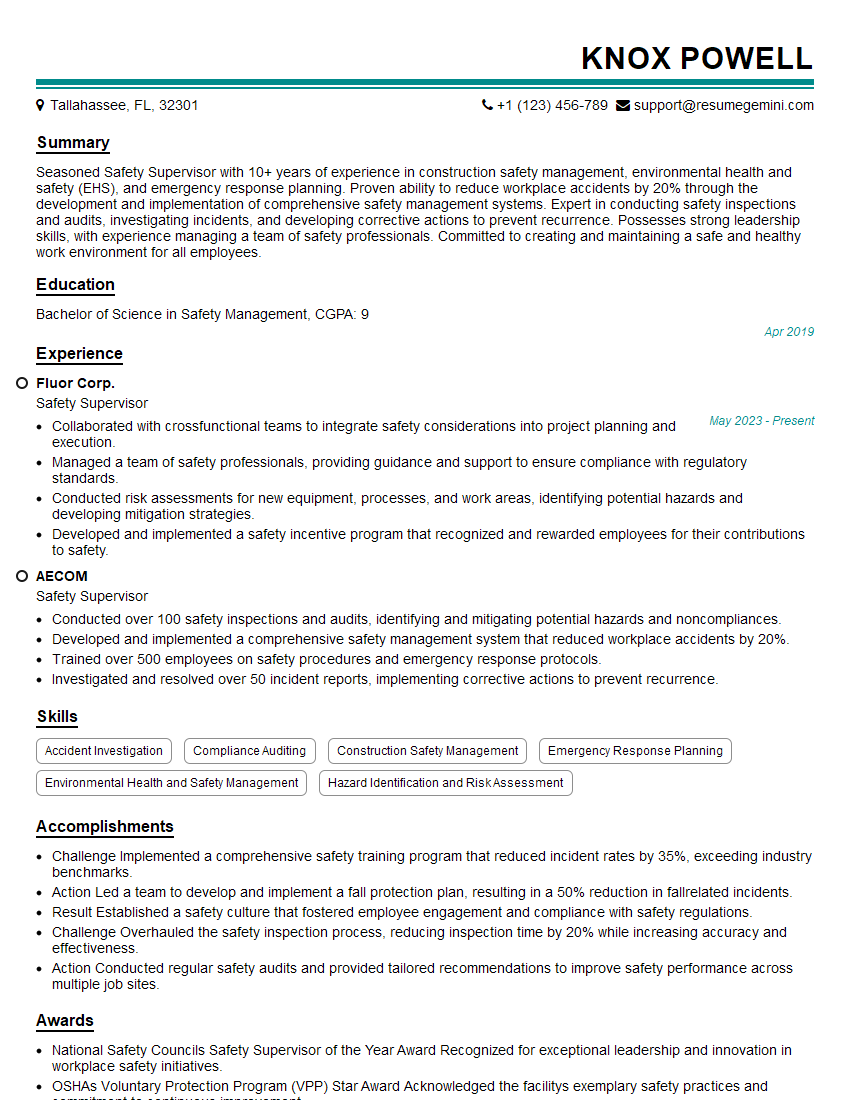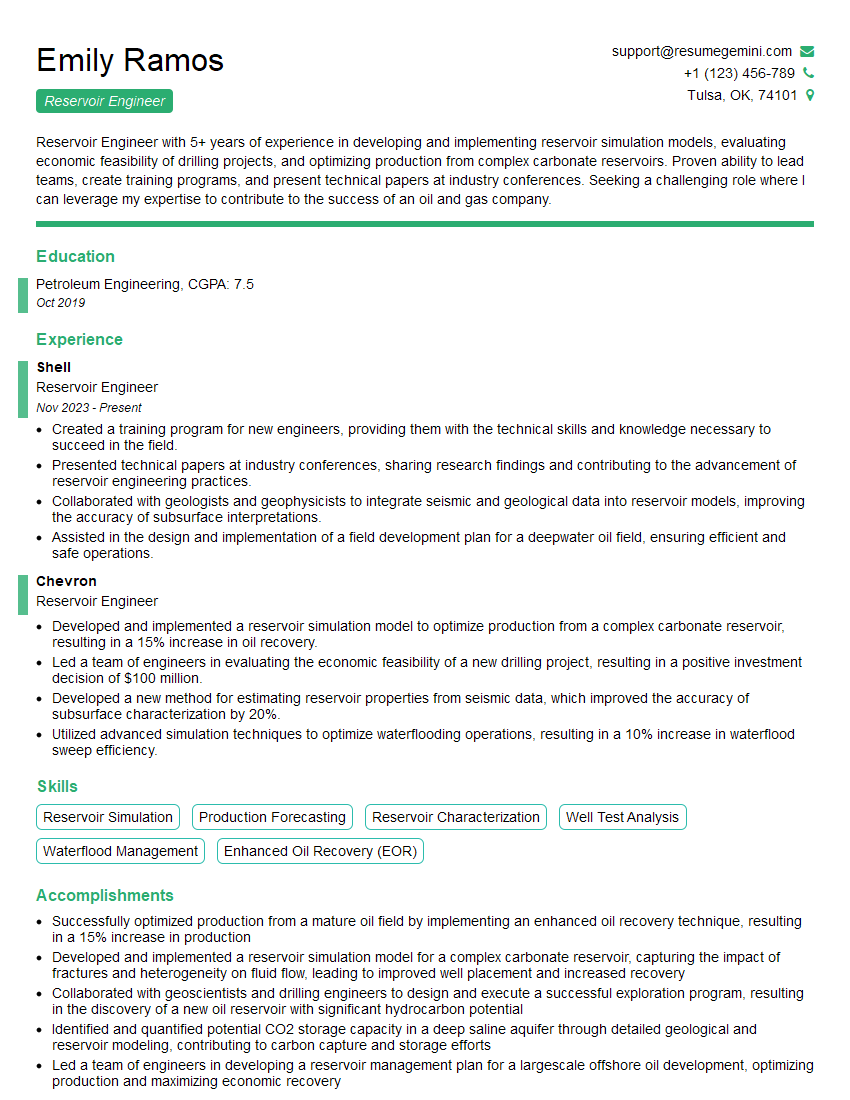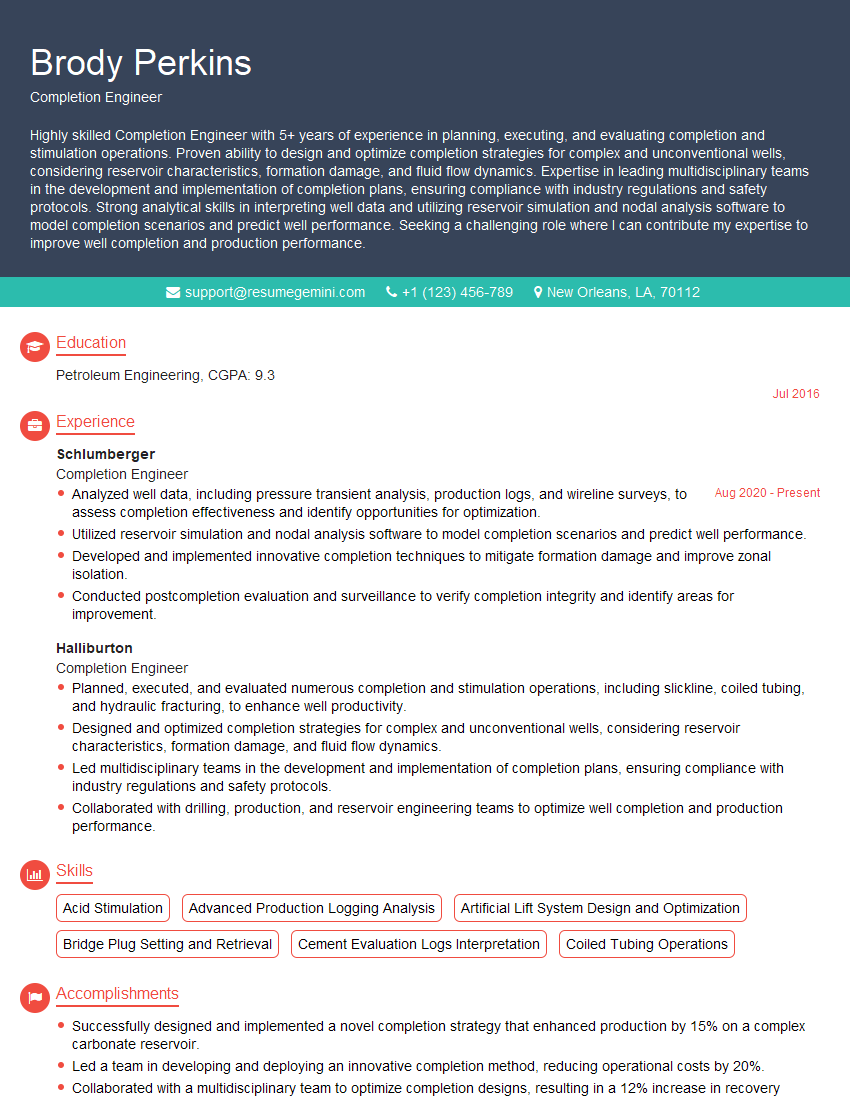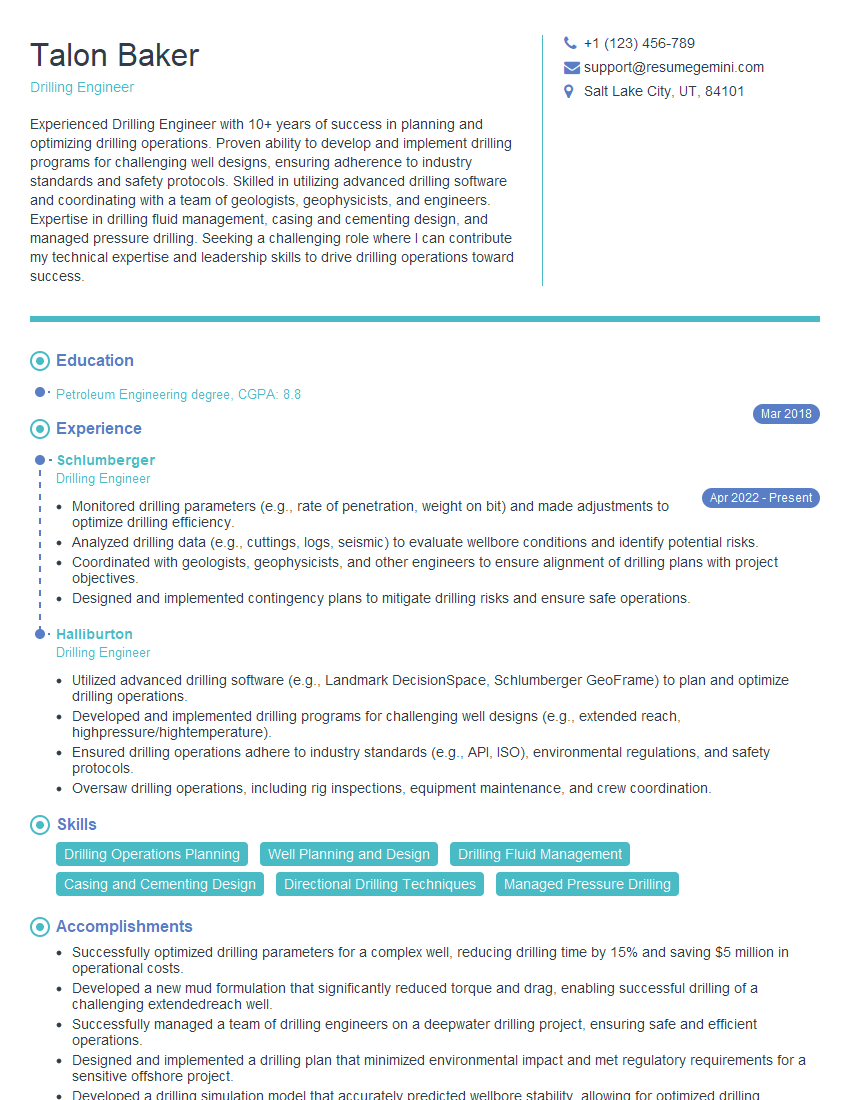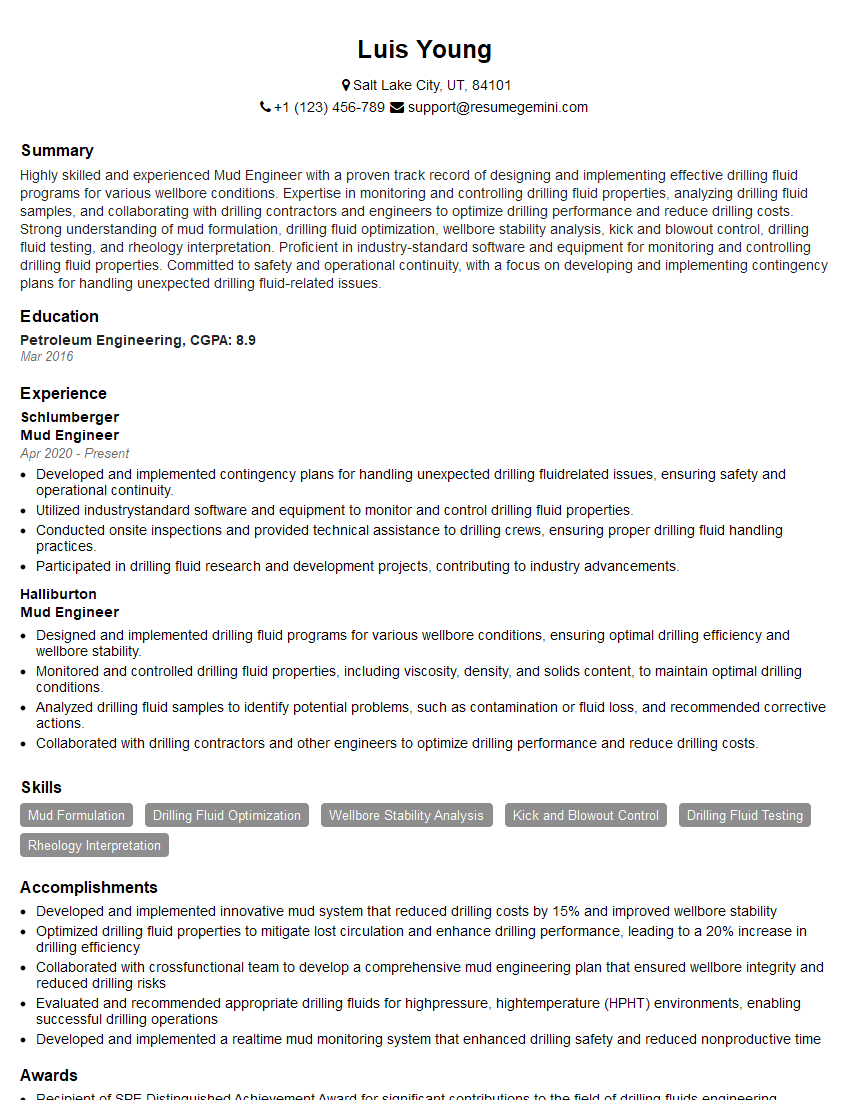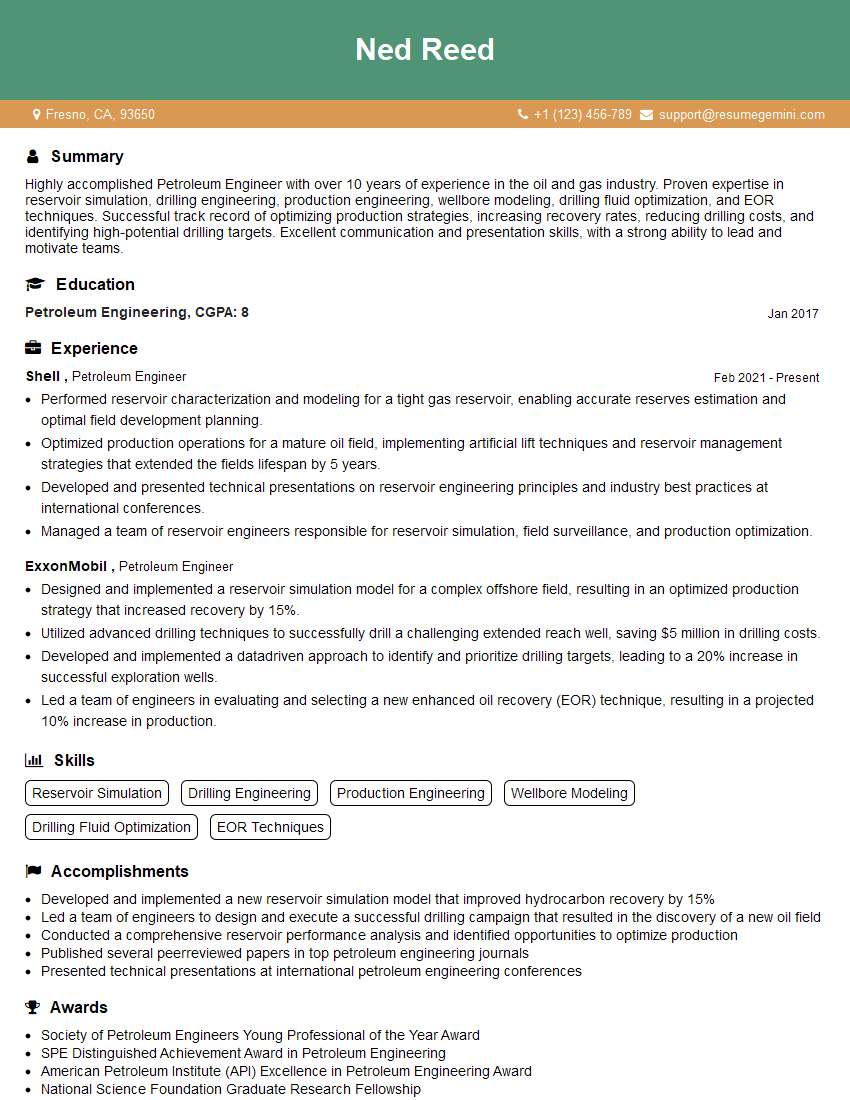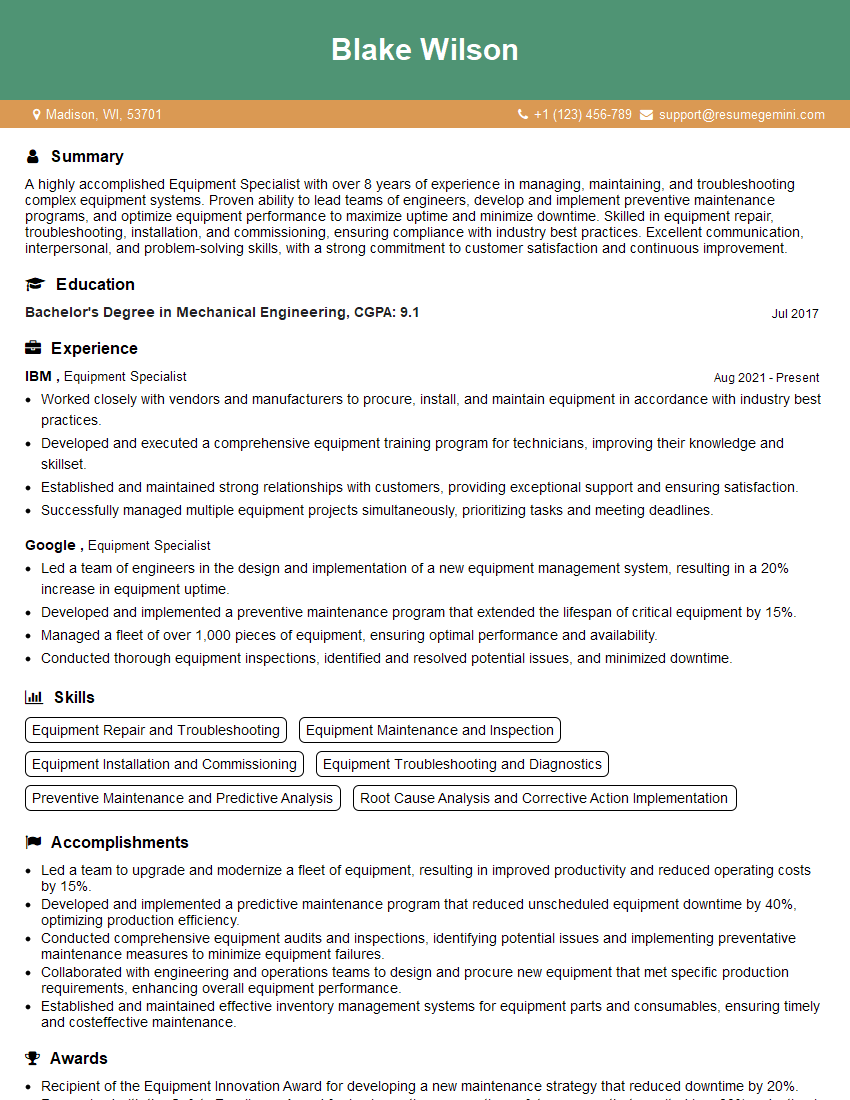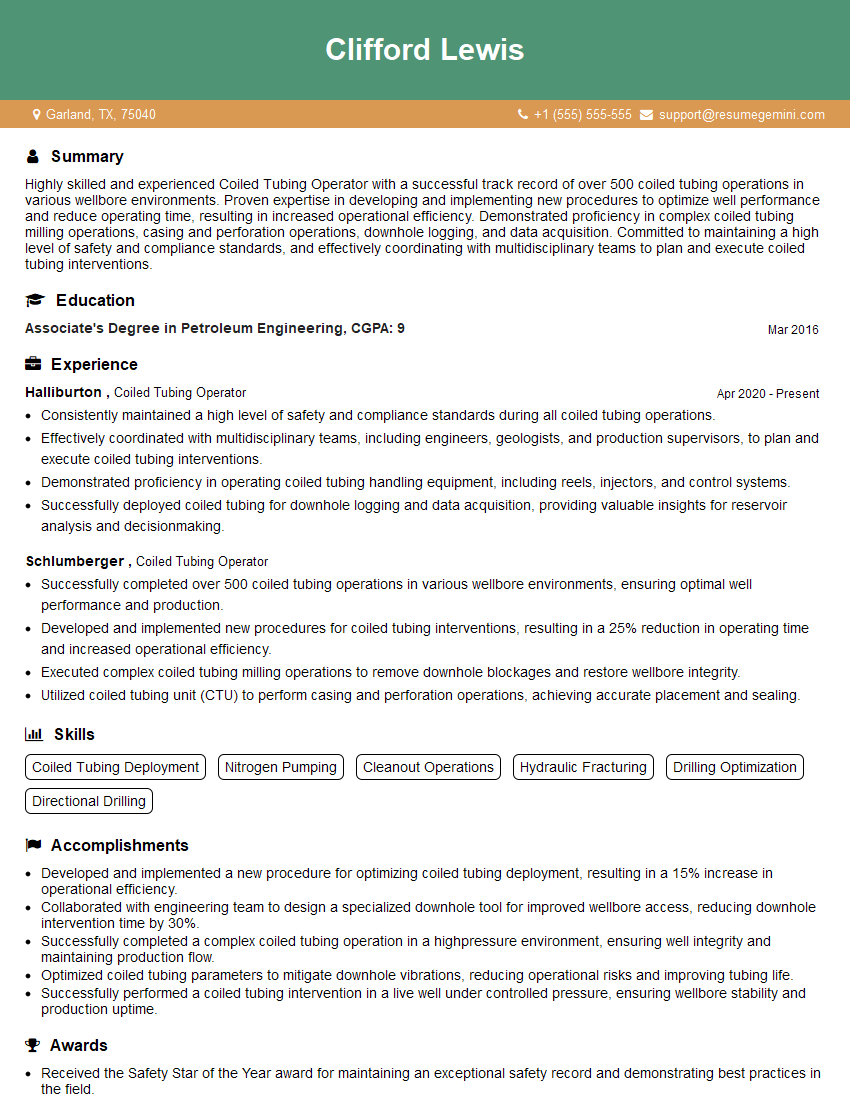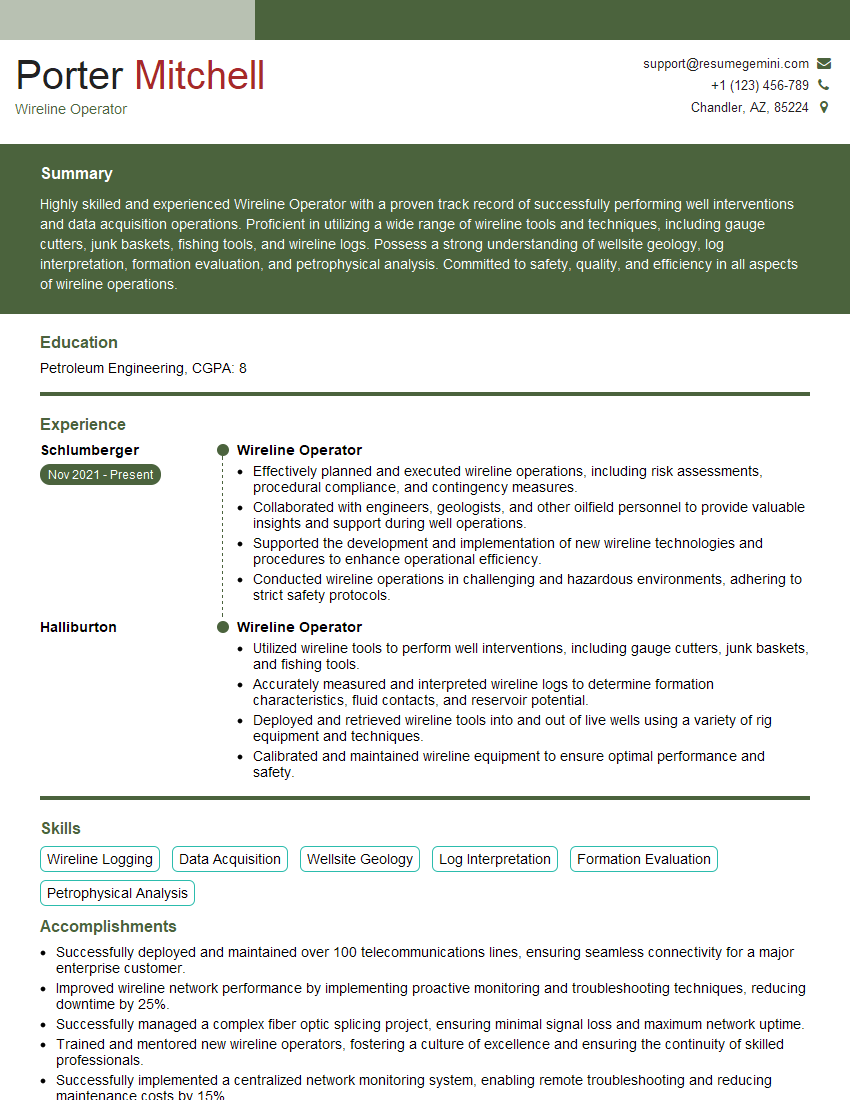Interviews are more than just a Q&A session—they’re a chance to prove your worth. This blog dives into essential Oil and Gas Well Servicing interview questions and expert tips to help you align your answers with what hiring managers are looking for. Start preparing to shine!
Questions Asked in Oil and Gas Well Servicing Interview
Q 1. Explain the different types of well servicing operations.
Well servicing encompasses a wide range of operations aimed at maintaining, repairing, or enhancing the productivity of oil and gas wells throughout their lifecycle. These operations can be broadly categorized as follows:
- Production Enhancement: This includes activities like acidizing (to dissolve formation damage and improve permeability), fracturing (hydraulic fracturing to create new pathways for hydrocarbons), and scale removal (to clean mineral deposits from wellbore surfaces). For example, acidizing a carbonate reservoir can significantly increase oil flow by dissolving the naturally occurring cement that restricts the flow of hydrocarbons.
- Workovers: These involve interventions to address problems in existing wells, such as replacing worn-out equipment (like downhole pumps or packers), repairing damaged casings, or plugging and abandoning sections of the well. Imagine a well that starts producing water; a workover might involve setting a new packer to isolate the water zone and redirect production from the oil zone.
- Completion and Well Testing: This includes the initial setup of the well after drilling (completion) and testing its performance to assess productivity. Completion operations might include setting downhole safety devices and production equipment.
- Intervention & Remedial Operations: These focus on resolving issues like stuck pipe (retrieving equipment stuck in the wellbore), lost circulation (sealing off channels that lose drilling mud), or well control issues (preventing uncontrolled flows). A common example is using specialized tools to free a fishing job stuck deep in the well.
- Decommissioning and Abandonment: These are the final stages of a well’s life, involving the safe removal of equipment, plugging the wellbore to prevent environmental contamination, and obtaining regulatory approval.
Q 2. Describe the safety procedures involved in well servicing.
Safety is paramount in well servicing. Procedures are rigorously defined and enforced to mitigate risks. Key safety aspects include:
- Pre-Job Planning & Risk Assessment: A detailed risk assessment is conducted before every operation to identify potential hazards and develop mitigation strategies. This includes considering well conditions, equipment integrity, and environmental factors.
- Emergency Response Planning: Comprehensive emergency response plans are in place to handle various scenarios, such as well control events, equipment failures, or medical emergencies. Regular drills are often conducted to ensure personnel are proficient in emergency procedures.
- Personal Protective Equipment (PPE): All personnel are required to wear appropriate PPE, including hard hats, safety glasses, gloves, and flame-resistant clothing. Specific PPE requirements vary depending on the operation being performed.
- Permit-to-Work Systems: A formal permit-to-work system is implemented, where a permit is issued only after all safety checks have been completed and signed off. This ensures that only authorized personnel can perform operations.
- Well Control Procedures: Strict well control procedures are followed to prevent uncontrolled well flow. This includes proper use of blowout preventers (BOPs) and other safety equipment. Regular BOP testing and maintenance are crucial.
- Hydrogen Sulfide (H2S) Safety: In wells producing H2S (a highly toxic gas), special precautions are taken, including using H2S monitors and providing personnel with H2S escape respirators.
Safety is not just a set of rules; it’s a culture. It requires constant vigilance and a commitment from every individual involved.
Q 3. What are the common causes of wellbore instability?
Wellbore instability is a significant challenge in oil and gas operations, leading to costly delays and potential safety risks. Common causes include:
- Formation Properties: Weak or fractured formations are prone to collapse. Shales, for instance, can swell and expand when exposed to drilling fluids, causing the wellbore to narrow or collapse.
- Drilling Fluid Properties: Inappropriate drilling fluid properties, such as excessive density or incorrect chemical composition, can cause wellbore instability. A fluid that’s too heavy can fracture the formation, while a fluid that’s too light might lead to shale swelling.
- Stress Conditions: High in-situ stresses in the formation can cause fractures or collapse. This is particularly problematic in high-pressure or high-temperature environments.
- Temperature Effects: High temperatures can alter the strength and stability of formations, leading to wellbore instability.
- Fluid Invasion: The invasion of drilling fluid into the formation can weaken the formation and potentially create unstable zones.
Understanding the geological characteristics of the formation and carefully selecting the appropriate drilling fluid are key to mitigating wellbore instability.
Q 4. How do you troubleshoot a stuck pipe situation?
A stuck pipe situation is a serious incident that requires immediate and careful action. Troubleshooting involves a systematic approach:
- Assessment: The first step is to accurately assess the situation. Determine the depth, severity (is it just stuck, or is there also a torque problem?), and suspected cause (e.g., differential sticking, key seating, or mechanical failure). This often involves running logging tools to gather information about the wellbore.
- Weighting-up and Weighting-down: Attempting to free the pipe by carefully increasing or decreasing the weight on the drill string. This can help break any mechanical locks.
- Rotation and reciprocation: Applying rotation or reciprocating motion (up and down) to the drill string to break free any friction or mechanical jams.
- Circulation: Circulating the drilling mud to remove cuttings or debris that might be causing the stuck pipe. Sometimes, adding specialized chemicals to the mud can help.
- Mechanical Methods: If the above techniques are unsuccessful, more aggressive mechanical methods might be needed. These could include using jar devices (to create impact), using overpull (applying extra force), or even employing specialized fishing tools to retrieve the stuck pipe.
- Abandonment (worst case): In extreme situations where the stuck pipe cannot be retrieved, the decision might be made to abandon the section of pipe and potentially re-drill.
Each step requires careful monitoring of downhole pressures and conditions to avoid further complications. Expert judgment and experience are crucial in making the right decisions during a stuck pipe incident.
Q 5. Explain the process of performing a well kill.
A well kill is a procedure used to control an uncontrolled flow of hydrocarbons from a well, preventing potential blowouts and environmental damage. The process generally involves these steps:
- Isolate the flow: The first step is to isolate the uncontrolled flow using the BOPs (blowout preventers) at the wellhead.
- Prepare the kill mud: A special mud heavier than the formation fluid is prepared. This mud will be used to stop the flow of hydrocarbons from the well.
- Circulate the kill mud: The kill mud is then circulated down the wellbore to displace the hydrocarbons and build up hydrostatic pressure to counter the well’s pressure.
- Wait and monitor: The well is monitored for any signs of pressure build-up or hydrocarbon flow.
- Repeat as needed: The process of circulating kill mud and monitoring is repeated until the well is completely shut down.
- Cementing: Once the well is effectively killed, the wellbore might be cemented to permanently seal it.
The specifics of a well kill depend on factors like the type of well, the pressure conditions, and the fluid properties. Well kill procedures require a highly skilled and experienced well control team, and proper training and drills are essential.
Q 6. Describe your experience with coiled tubing operations.
I have extensive experience in coiled tubing operations, encompassing a wide range of applications. Coiled tubing is a highly versatile technology, offering numerous advantages over traditional drill string operations, particularly for intervention and stimulation work.
My experience includes:
- Stimulation treatments: Using coiled tubing to deliver acid, fracturing fluids, or proppants to enhance well productivity.
- Well cleaning: Removing debris or scale from the wellbore using coiled tubing to increase production efficiency.
- Fishing operations: Retrieving lost or damaged equipment from the wellbore using coiled tubing-based fishing tools.
- Plugging and abandonment: Deploying specialized tools and fluids via coiled tubing to plug and abandon well sections in a safe and efficient manner.
- Mill and ream operations: Enhancing the wellbore diameter using coiled tubing to improve flow efficiency.
I’m proficient in troubleshooting coiled tubing operations and familiar with various coiled tubing units and associated equipment. I’m also experienced in the safety protocols unique to coiled tubing interventions.
For example, I once successfully used coiled tubing to retrieve a critical downhole valve that had become stuck in a high-pressure, high-temperature well. This prevented costly workovers and kept the well online.
Q 7. What are the different types of well completion methods?
Well completion methods are crucial for maximizing hydrocarbon production and ensuring well integrity. The choice of completion method depends on reservoir characteristics, formation properties, and production objectives. Common methods include:
- Openhole Completion: This involves leaving the wellbore open after drilling, allowing hydrocarbons to flow freely into the well. This is often used in high-permeability reservoirs.
- Cased-Hole Completion: This involves casing (lining) the wellbore with steel pipe (casing) and perforating it to allow hydrocarbons to enter the well. This offers better wellbore stability and control.
- Gravel Pack Completion: This involves placing a layer of gravel around the wellbore to prevent formation sand from entering the well and hindering production. This is typically used in unconsolidated formations.
- Packer Completion: This involves using packers to isolate different zones within the wellbore, allowing for selective production from specific intervals.
- Multi-Stage Fracturing Completion: For unconventional resources, this method utilizes multiple stages of hydraulic fracturing to stimulate production from different sections of a horizontal well.
- Underbalanced Completion: This is used in situations where low wellbore pressure is maintained throughout the completion process to minimize formation damage.
The selection of a suitable completion method is a critical engineering decision requiring detailed reservoir and formation analysis.
Q 8. Explain the importance of wellhead maintenance.
Wellhead maintenance is paramount for ensuring the safe and efficient operation of an oil and gas well throughout its entire lifecycle. The wellhead is the interface between the subsurface reservoir and the surface equipment, acting as a crucial pressure barrier. Neglecting maintenance can lead to catastrophic failures, environmental disasters, and significant financial losses.
- Preventing Leaks: Regular inspections and maintenance prevent leaks of hydrocarbons, which are not only environmentally damaging but also pose safety risks through fire or explosion hazards.
- Maintaining Pressure Integrity: The wellhead’s components, including the casing head, tubing head, and various valves, must be in perfect working order to maintain the well’s pressure integrity. Failure can lead to uncontrolled well flow (blowouts).
- Extending Well Life: Proper maintenance extends the operational life of the well by preventing premature corrosion and wear of critical components.
- Ensuring Safety: Wellhead maintenance is crucial for worker safety, reducing the risk of accidents caused by equipment failure.
For example, I once worked on a well where a poorly maintained wellhead valve caused a minor leak. Early detection and timely repair averted a larger environmental incident. The repair included replacing worn-out seals and conducting a thorough pressure test. This experience reinforced the criticality of proactive maintenance.
Q 9. How do you identify and address potential environmental hazards during well servicing?
Identifying and addressing potential environmental hazards during well servicing requires a multi-faceted approach emphasizing prevention, preparedness, and response. This involves strict adherence to regulations, risk assessments, and emergency response plans.
- Pre-Job Risk Assessment: Before any operation, a thorough risk assessment is conducted to identify potential environmental hazards such as spills, leaks, or emissions of harmful substances. This assessment involves analyzing the well’s history, geological conditions, and the specific tasks involved.
- Spill Prevention & Containment: Implementing measures to prevent spills includes using proper containment equipment such as berms, spill trays, and absorbent materials. Regular inspections of this equipment are vital.
- Waste Management: Proper handling and disposal of drilling fluids, cuttings, and other waste materials are crucial to minimizing environmental impact. This involves adherence to local and national regulations.
- Emergency Response Plan: A well-defined emergency response plan is essential to quickly and effectively address any unplanned events. This plan should outline procedures for containing spills, notifying relevant authorities, and mitigating environmental damage.
- Monitoring & Reporting: Continuous monitoring of environmental parameters (e.g., water quality, air quality) during and after operations is essential. Regular reporting of environmental data to regulatory bodies is mandatory.
For instance, during a workover operation, we encountered an unexpected influx of formation water. Our pre-planned containment system prevented significant environmental damage. We immediately implemented our spill response plan, contained the water, analyzed its composition, and reported the incident to the relevant environmental agencies.
Q 10. What is your experience with hydraulic fracturing operations?
I have extensive experience in hydraulic fracturing (fracking) operations, encompassing all phases from pre-job planning to post-job cleanup. My experience includes both conventional and unconventional resource development projects.
- Pre-Job Planning: This involves reviewing well data, designing the fracturing program, procuring the necessary equipment and materials, and obtaining all necessary permits.
- Execution: Directly overseeing the fracturing operation itself, including managing the fracturing fluids, proppant placement, and monitoring pressure and flow rates.
- Post-Job Analysis: Analyzing the data collected during the fracturing operation to optimize future operations and evaluate the effectiveness of the treatment.
In a recent project involving shale gas extraction, I played a key role in optimizing the fracturing design, resulting in a significant increase in production. By carefully analyzing the geological data and employing advanced simulation techniques, we were able to tailor the fracturing parameters to maximize hydrocarbon recovery while minimizing environmental impact.
Q 11. Describe your experience with wireline logging operations.
My experience with wireline logging operations spans various techniques, including open hole and cased hole logging. I am proficient in running, monitoring, and interpreting the data acquired from different logging tools.
- Open Hole Logging: This involves running logging tools in an uncased borehole to acquire data on formation properties such as porosity, permeability, and lithology.
- Cased Hole Logging: This entails running logging tools through the casing to assess the condition of the wellbore and the surrounding formations.
- Data Interpretation: Analyzing the acquired data to create a comprehensive geological model of the reservoir, which is crucial for reservoir management and production optimization.
I recall a project where wireline logging identified a previously unknown fault zone. This information proved crucial in modifying the completion strategy, ultimately leading to significant improvements in well productivity. This highlights the importance of accurately interpreting the data.
Q 12. Explain the process of running and interpreting a pressure test.
Running and interpreting a pressure test, often a drill stem test (DST) or a formation integrity test (FIT), is fundamental for assessing wellbore integrity and reservoir properties. It involves systematically pressurizing the well and analyzing the pressure response.
- Test Preparation: This includes preparing the well, installing the necessary equipment, and defining the test parameters.
- Test Execution: The well is pressurized to a specific level, and the pressure response is carefully monitored over time.
- Data Acquisition: Pressure, temperature, and flow rate data are recorded during the test.
- Data Interpretation: The pressure data is analyzed using specialized software to determine reservoir parameters such as permeability, pore pressure, and the presence of any fluid communication pathways.
A recent example involved a FIT performed on a newly drilled well. The pressure test revealed a significant leak in the casing, which was promptly addressed before completion, preventing costly rework and environmental risk. Correct interpretation is crucial for decision-making.
Q 13. What are the common causes of well control incidents?
Well control incidents, which can range from minor leaks to catastrophic blowouts, often stem from a combination of factors, frequently human error combined with equipment malfunction.
- Equipment Failure: Failures of critical well control equipment such as blowout preventers (BOPs), valves, or pressure gauges can lead to uncontrolled well flow.
- Human Error: Improper well control procedures, inadequate training, or poor judgment can contribute significantly to well control incidents.
- Kick: An influx of formation fluids into the wellbore (kick) can overwhelm the well control system if not properly managed.
- Poor Cementing: Inadequate cementing of the casing can create pathways for fluids to flow to the surface.
- Lack of Maintenance: Poor maintenance of equipment and wellhead components can weaken pressure integrity and lead to failures.
I have witnessed several incidents where human error, such as failure to properly monitor pressure during a drilling operation, resulted in a kick. Strict adherence to well control procedures and regular equipment inspections are key to preventing such occurrences.
Q 14. How do you ensure the integrity of well casing?
Ensuring the integrity of well casing is essential for preventing leaks, maintaining wellbore stability, and protecting the environment. It’s a continuous process that starts during drilling and continues throughout the well’s life.
- Proper Casing Design: The casing string must be adequately designed to withstand the expected pressures and temperatures.
- Quality Cementing: Proper cementing is crucial to creating a robust seal between the casing and the formation, preventing fluid migration.
- Regular Inspections: Periodic inspections, using various methods like pressure testing and logging tools, help detect any deterioration or damage to the casing.
- Corrosion Monitoring: Monitoring for corrosion and implementing corrosion prevention techniques are critical in extending the life of the casing.
- Repair & Remedial Actions: If damage is detected, timely repair or remedial actions, such as casing repair or cement squeeze jobs, are crucial.
In one instance, we used advanced logging techniques to detect minor casing corrosion that wasn’t apparent during routine inspections. Early intervention with a chemical treatment significantly extended the life of the casing string and avoided a costly workover.
Q 15. Describe your experience with different types of wellhead equipment.
My experience encompasses a wide range of wellhead equipment, from traditional Christmas trees to advanced automated systems. I’ve worked extensively with various types, including:
- Conventional Wellheads: These are the standard, manually operated systems, requiring direct manipulation of valves and pressure control devices. I’ve worked on numerous installations and repairs, ensuring proper sealing and pressure integrity. For example, I recall troubleshooting a leaking annulus valve on a conventional wellhead during a workover operation, requiring careful inspection and replacement of a worn-out seal.
- Automated Wellheads: These systems use hydraulic or electric actuators for remote control of valves, enhancing safety and efficiency. My experience includes programming and maintenance of these systems, ensuring reliable remote operation. I’ve personally overseen the installation and commissioning of several automated wellheads, minimizing downtime and improving operational safety.
- Subsea Wellheads: While I haven’t directly worked *on* subsea wellheads (that usually requires specialized ROV intervention), I have significant experience with the surface control systems that manage them, understanding the pressure and flow parameters critical for their safe operation. This includes analyzing data from subsea sensors to identify potential issues.
My expertise extends beyond just operation; I understand the intricacies of wellhead design, materials selection, and maintenance protocols crucial for preventing costly failures and ensuring environmental safety.
Career Expert Tips:
- Ace those interviews! Prepare effectively by reviewing the Top 50 Most Common Interview Questions on ResumeGemini.
- Navigate your job search with confidence! Explore a wide range of Career Tips on ResumeGemini. Learn about common challenges and recommendations to overcome them.
- Craft the perfect resume! Master the Art of Resume Writing with ResumeGemini’s guide. Showcase your unique qualifications and achievements effectively.
- Don’t miss out on holiday savings! Build your dream resume with ResumeGemini’s ATS optimized templates.
Q 16. Explain the process of cementing a well.
Cementing a well is a critical process that secures the casing within the wellbore, preventing fluid migration and ensuring well integrity. It’s a multi-stage process:
- Planning & Design: This involves selecting the appropriate cement slurry based on the well’s geological conditions, depth, and expected pressures. This includes determining the cement type, additives (to control setting time, density, and rheology), and the placement strategy.
- Slurry Mixing: The cement powder is mixed with water and additives in a specialized blender, ensuring a homogeneous mixture with the desired properties. Consistency is crucial; incorrect mixing can lead to poor cement placement and weakened seals.
- Cement Placement: The slurry is pumped down the casing annulus (the space between the casing and the wellbore wall) using specialized pumping equipment. This process requires precise control of pressure and flow rates to ensure complete and even cement placement.
- Displacement & Circulation: After placement, the cement is displaced by a spacer fluid (to prevent contamination), followed by a final displacement fluid (e.g., drilling mud) to clean the wellbore. This helps ensure a clean interface between the cement and the surrounding formations.
- Curing & Monitoring: The cement is allowed to cure (set), during which temperature and pressure changes are closely monitored. This ensures proper cement hardening and confirms the integrity of the cement job. We use logging tools to verify the cement has filled the annulus fully.
A failed cement job can lead to costly complications like casing collapse, formation fracturing, and environmental contamination, highlighting the importance of meticulous planning and execution.
Q 17. How do you manage a team during a well servicing operation?
Managing a team during a well servicing operation requires strong leadership, communication, and safety focus. My approach is built on:
- Clear Communication: Before, during, and after the operation, clear communication is paramount. Pre-job briefings ensure everyone understands their roles, responsibilities, and safety procedures. Regular updates during the operation keep everyone informed, enabling proactive problem-solving.
- Delegation & Empowerment: I delegate tasks based on team members’ skills and experience, fostering a sense of ownership and responsibility. I empower them to make decisions within their scope of authority, fostering a collaborative and efficient environment.
- Safety First Mentality: Safety is my top priority. I relentlessly enforce safety regulations and procedures, ensuring all team members follow protocols meticulously. This includes regular safety checks and prompt response to any potential hazards.
- Problem-Solving & Adaptability: Well servicing operations are dynamic; unexpected problems arise. I work with the team to identify the root causes and implement effective solutions, adapting our approach as needed. For example, during a recent workover, we encountered an unexpected equipment failure. I guided the team through troubleshooting and provided alternative solutions using available resources to minimize downtime and avoid compromising the operation.
Building a strong team requires trust, respect, and a shared commitment to safe and efficient operations. I strive to create a positive and supportive work environment where every team member feels valued and empowered.
Q 18. Describe your experience with troubleshooting well servicing equipment.
Troubleshooting well servicing equipment requires a systematic approach combining technical knowledge, experience, and problem-solving skills. I typically follow these steps:
- Identify the Problem: Carefully assess the malfunction, gathering data from gauges, sensors, and operator reports. For example, a sudden drop in pumping pressure might indicate a blockage in the tubing or a problem with the pump itself.
- Analyze the System: Review the operational history, checking for any recent changes or modifications that might have contributed to the problem. A systematic review of all components in the system is critical.
- Isolate the Fault: Using diagnostic tools and tests, isolate the faulty component. This might involve checking pressure gauges, flow meters, electrical connections, or hydraulic systems.
- Implement Corrective Actions: Once the fault is identified, implement the necessary repairs or replacements, following established safety procedures.
- Verification & Testing: After repairs, thoroughly test the system to ensure it’s functioning correctly before resuming operations. Documentation is crucial during troubleshooting process to prevent recurring issues.
My experience includes troubleshooting a wide range of equipment, from pumps and valves to control systems and downhole tools. I have a strong understanding of hydraulic, pneumatic, and electrical systems, allowing me to diagnose and resolve complex issues efficiently and safely.
Q 19. What are your experience with different types of pumping equipment?
My experience with pumping equipment spans various types, each suited to specific well servicing tasks:
- Positive Displacement Pumps (PDP): These pumps, like triplex pumps, are essential for high-pressure applications, such as cementing and acidizing. I have significant experience operating, maintaining, and troubleshooting these pumps, focusing on proper packing and fluid compatibility.
- Centrifugal Pumps: Used for higher flow rates at lower pressures, these are often employed in fluid transfer and circulation operations. I understand the importance of proper impeller selection and balancing for efficient operation.
- Mud Pumps: These high-capacity pumps are critical for circulating drilling mud during drilling and workover operations. My experience includes managing mud pump pressure and flow rates to optimize wellbore cleaning and cuttings removal.
- Specialized Pumps: I’ve worked with specialized pumps for specific applications, such as nitrogen pumps for pressure testing and chemical injection pumps for stimulation treatments. I understand the safety precautions required for handling different chemicals.
Understanding the capabilities and limitations of each pump type is crucial for selecting the right equipment for a given task and ensuring optimal performance and safety. For example, using a centrifugal pump for a high-pressure cementing job would be a grave mistake.
Q 20. What safety measures are taken during a well servicing operation?
Safety is paramount in well servicing operations. We adhere to a comprehensive safety program, including:
- Risk Assessments: Thorough risk assessments are conducted before every operation to identify and mitigate potential hazards. This process involves identifying potential hazards and establishing control measures to prevent injuries and accidents.
- Emergency Response Plan: A detailed emergency response plan is in place, outlining procedures for various scenarios, including well control events, equipment failure, and medical emergencies. This plan includes designated roles and communication protocols.
- Personal Protective Equipment (PPE): Appropriate PPE, including hard hats, safety glasses, gloves, and flame-resistant clothing, is mandatory for all personnel. Regular PPE inspections are conducted to maintain safety standards.
- Permit-to-Work System: A stringent permit-to-work system ensures that all tasks are authorized and completed safely. This includes ensuring proper isolation and lockout/tagout procedures.
- Training & Competency: Regular training is provided to ensure all personnel are competent in their roles and understand the safety procedures. We use practical simulations to reinforce training and prepare for real world emergencies.
Safety is not just a set of rules; it’s a mindset, a culture ingrained in every aspect of our operations. We foster a safety-conscious environment where every individual feels empowered to stop unsafe practices.
Q 21. How do you handle emergencies during a well servicing operation?
Handling emergencies during a well servicing operation requires swift, decisive action based on a well-defined emergency response plan. My approach involves:
- Activate Emergency Response Plan: Immediately activate the pre-established emergency response plan, notifying relevant personnel and authorities as required. This includes contacting emergency services if necessary.
- Assess the Situation: Quickly assess the nature and extent of the emergency, identifying immediate threats and potential consequences. This might include determining the cause of the problem and evaluating its impact on personnel and equipment.
- Implement Control Measures: Implement appropriate control measures to mitigate the immediate risks. This might involve shutting down equipment, evacuating personnel, or initiating well control procedures.
- Communicate Effectively: Maintain clear and consistent communication with all involved parties, keeping everyone informed of the situation and planned actions. This includes regular updates to management, emergency services, and regulatory bodies.
- Post-Incident Investigation: After the emergency is resolved, a thorough post-incident investigation is conducted to identify the root causes, assess the effectiveness of the response, and implement corrective actions to prevent future occurrences. This ensures lessons learned are applied to improve safety and efficiency.
My experience includes managing several emergencies, from equipment malfunctions to minor well control events. My ability to remain calm under pressure, make rational decisions, and effectively lead the team through these critical situations is a significant strength.
Q 22. What are the common challenges faced during well servicing operations?
Well servicing operations, while crucial for maintaining the productivity and safety of oil and gas wells, face numerous challenges. These challenges can be broadly categorized into operational, environmental, and regulatory aspects.
- Operational Challenges: These include equipment malfunctions, unexpected wellbore conditions (e.g., unexpected pressure surges, formation instability), difficult access to remote well sites, and limitations in available technology for complex interventions. For instance, a sudden sand influx during a workover can halt operations and require specialized equipment and expertise to address safely.
- Environmental Challenges: Minimizing environmental impact is paramount. Challenges include preventing spills, managing produced water disposal, mitigating greenhouse gas emissions, and adhering to strict environmental regulations. A blowout preventer (BOP) failure, for example, could lead to a significant environmental disaster with far-reaching consequences.
- Regulatory Challenges: Stringent health, safety, and environmental regulations necessitate meticulous planning, risk assessment, and documentation. Failure to comply can result in significant penalties and operational delays. Ensuring all crew members are properly trained and certified to handle specific tasks and emergency situations is a vital part of regulatory compliance.
Addressing these challenges requires a proactive approach, including thorough planning, employing advanced technologies, robust risk management strategies, and a commitment to continuous improvement in safety and environmental practices.
Q 23. Explain the importance of maintaining accurate well logs.
Accurate well logs are the cornerstone of successful well servicing and production management. They provide a detailed record of the subsurface formations encountered during drilling and subsequent operations. This information is essential for making informed decisions about well completion, stimulation, and production optimization.
- Well Completion Design: Well logs help determine the best placement of casing, perforations, and completion equipment to maximize production from target zones. For example, identifying the presence of fractures or high-permeability layers informs the strategic design of the well’s completion.
- Reservoir Characterization: They reveal information about reservoir properties, such as porosity, permeability, and fluid saturation. This helps engineers understand reservoir behavior and predict production performance.
- Production Optimization: Monitoring changes in well logs over time allows for the identification of production issues, such as water or gas coning, and helps in optimizing production strategies. For instance, a decline in permeability over time can be detected through log analysis and addressed through interventions such as acidizing.
- Well Intervention Planning: Accurate logs are crucial for planning successful well interventions, including workovers, stimulation treatments, and remedial operations. They provide the necessary data to guide the selection of appropriate tools and techniques.
In essence, well logs serve as a ‘fingerprint’ of the well, enabling optimal management across its lifecycle.
Q 24. How do you ensure compliance with regulatory requirements?
Compliance with regulatory requirements is not just a legal obligation; it’s fundamental to safety and environmental protection. We ensure compliance through a multi-faceted approach:
- Pre-Job Planning and Risk Assessment: Every operation begins with a comprehensive risk assessment, identifying potential hazards and developing mitigation strategies. This involves reviewing all applicable regulations and permits.
- Strict Adherence to Procedures and Standards: Our operations adhere strictly to industry best practices, operational procedures, and company safety manuals. This includes regular equipment inspections and maintenance to prevent failures.
- Training and Certification: All personnel involved in well servicing operations receive comprehensive training and hold the necessary certifications to perform their tasks safely and competently. We emphasize safety training, including emergency response procedures.
- Data Management and Reporting: We maintain meticulous records of all operations, including well logs, pressure data, chemical usage, and safety incidents. This data is used for regulatory reporting and continuous improvement initiatives.
- Environmental Monitoring: Environmental monitoring throughout the operation is crucial. This includes regular inspections for spills, air quality monitoring, and proper waste management. We always work to minimize our environmental footprint.
Regular audits and internal reviews ensure that our compliance systems remain effective and up-to-date with evolving regulations.
Q 25. Describe your experience with different types of well control equipment.
My experience encompasses a wide range of well control equipment, essential for preventing wellbore kicks (uncontrolled influx of formation fluids) and ensuring safe operations. This includes:
- Blowout Preventers (BOPs): I’m proficient in operating, maintaining, and troubleshooting various BOP stack configurations, including annular preventers, ram preventers, and shear rams. I understand the critical role BOPs play in preventing uncontrolled well blowouts, and I’ve participated in numerous BOP testing and maintenance procedures.
- Wellhead Equipment: I have hands-on experience with various wellhead components, such as christmas trees, manifolds, and flow lines. This involves understanding their function, pressure ratings, and safe operating procedures.
- Mud Pumps and Circulating Systems: My experience extends to operating and maintaining high-pressure mud pumps and circulating systems, which are crucial for controlling well pressure and removing cuttings during drilling and completion operations.
- Choke Manifolds and Control Systems: I’m familiar with using choke manifolds and control systems to manage well pressure and flow rates during well testing and production operations. Understanding the proper procedures for choke manipulation is critical for pressure control.
Understanding the limitations and capabilities of this equipment, coupled with rigorous maintenance practices, is crucial for safe and effective well servicing operations. I’ve personally addressed several critical situations leveraging my well control knowledge and experience.
Q 26. Explain the process of performing a well stimulation treatment.
Well stimulation treatments are designed to enhance hydrocarbon production from a reservoir by increasing its permeability and improving fluid flow. The process typically involves several key steps:
- Well Preparation: This includes running logging tools to determine the reservoir characteristics and identifying the optimal treatment zone. This might involve gathering data on formation properties, identifying potential fracture zones, and optimizing the treatment design.
- Treatment Design: Based on the well log data and reservoir simulation, the stimulation treatment is designed. This involves selecting the appropriate stimulation method (e.g., hydraulic fracturing, acidizing), determining the required volume and pressure of the stimulation fluid, and selecting the proper proppants (if applicable).
- Treatment Execution: This involves pumping the stimulation fluid (e.g., water, acid, or a fracturing fluid) into the wellbore at controlled rates and pressures. Real-time monitoring of pressure and flow rates is vital throughout the treatment to ensure efficacy and to avoid causing damage to the well.
- Post-Treatment Evaluation: After the treatment, various evaluation techniques are used to assess its effectiveness. This might include pressure tests, production logging, and core analysis.
For example, in hydraulic fracturing, high-pressure fluid is injected to create fractures in the formation. Proppants, such as sand, are added to keep the fractures open, improving permeability. Acidizing involves injecting acid into the formation to dissolve near-wellbore damage, improving fluid flow. The success of the stimulation treatment is measured by the increased hydrocarbon production rate.
Q 27. What are your experience with different types of well intervention techniques?
My experience with well intervention techniques is extensive and covers a broad range of operations designed to address various wellbore issues and optimize production.
- Fishing and Retrieving: I’ve participated in numerous operations to retrieve dropped tools or equipment from the wellbore, using specialized fishing tools and techniques. This involves careful planning and execution to avoid further damage to the well.
- Coiled Tubing Operations: I have hands-on experience using coiled tubing for various interventions, including well cleaning, cementing, acidizing, and stimulation treatments. This offers flexibility and efficiency compared to conventional workover rigs.
- Workovers: I’ve worked on numerous workovers, which involve repairing, maintaining, or modifying wells to restore or enhance production. This might include replacing damaged equipment, re-perforating the wellbore, or installing new completion equipment.
- Plugging and Abandonment: I’m experienced in properly plugging and abandoning wells, ensuring they are sealed to prevent environmental contamination and future hazards. This involves following strict procedures and documentation to meet regulatory requirements.
- Completion and Stimulation: As detailed previously, I’m highly experienced in designing and executing various well completion and stimulation treatments.
Choosing the appropriate well intervention technique is critical and hinges on a thorough understanding of wellbore conditions, production challenges, and the available resources. Effective well intervention significantly impacts production optimization, cost reduction, and environmental protection.
Key Topics to Learn for Oil and Gas Well Servicing Interview
- Well Control: Understanding fundamental well control principles, including pressure management, BOP operations, and emergency response procedures. Practical application: Describing your experience (or theoretical understanding) of handling various well control scenarios, such as kicks and losses.
- Drilling Fluids (Mud): Knowledge of mud properties, functions (e.g., pressure control, wellbore stability), and the importance of proper mud engineering. Practical application: Explaining how different mud types are selected based on formation characteristics and drilling challenges.
- Completion and Workover Operations: Understanding the processes involved in completing a well (preparing it for production) and performing workovers (maintenance and repairs). Practical application: Detailing your experience with different completion techniques or workover procedures, such as stimulation treatments or well intervention.
- Production Logging and Testing: Familiarization with techniques used to assess well productivity and diagnose production issues. Practical application: Explaining how production logging data informs decisions regarding well optimization and troubleshooting.
- Safety Procedures and Regulations: Demonstrate a strong understanding of HSE (Health, Safety, and Environment) regulations and best practices within the oil and gas industry. Practical application: Describing your experience implementing safety protocols and contributing to a safe work environment.
- Troubleshooting and Problem-Solving: Ability to analyze problems, identify root causes, and develop effective solutions in a high-pressure environment. Practical application: Providing examples of how you’ve successfully troubleshooted equipment malfunctions or addressed operational challenges.
- Equipment Knowledge: Familiarity with the operation and maintenance of various well servicing equipment (e.g., pumps, pressure vessels, lifting equipment). Practical application: Describing your experience operating or maintaining specific types of well servicing equipment.
Next Steps
Mastering Oil and Gas Well Servicing opens doors to a rewarding and dynamic career with significant growth potential. To maximize your job prospects, crafting a compelling and ATS-friendly resume is crucial. ResumeGemini is a trusted resource that can help you build a professional resume that highlights your skills and experience effectively. They provide examples of resumes tailored to the Oil and Gas Well Servicing sector, ensuring your application stands out. Take the next step in your career journey and create a resume that showcases your expertise.
Explore more articles
Users Rating of Our Blogs
Share Your Experience
We value your feedback! Please rate our content and share your thoughts (optional).
What Readers Say About Our Blog
Hi, I represent an SEO company that specialises in getting you AI citations and higher rankings on Google. I’d like to offer you a 100% free SEO audit for your website. Would you be interested?
good

